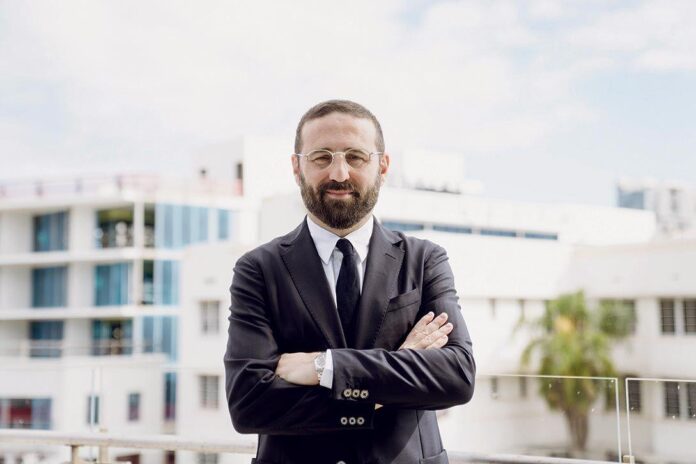Art Basel in Miami Beach has come a long way. The fair celebrates its 20th anniversary this year with its largest edition to date, featuring more than 280 exhibitors. It also welcomes a new leadership team, with Noah Horowitz taking on the newly created chief executive role at Art Basel (succeeding Marc Spiegler, the brand’s former global director), and Vincenzo de Bellis taking over as director of its four fairs, in Basel, Miami Beach, Hong Kong and Paris.
Horowitz, an art historian and former worldwide head of gallery and private dealer services at Sotheby’s, is returning to the fold, having served as Art Basel’s director of Americas from 2015 to 2021. De Bellis is also returning to the commercial sector, having been the artistic director of Milan’s contemporary art fair Miart from 2012 to 2016, before working at the Walker Art Center in Minneapolis as curator and associate director of programmes for the past six years. The pair’s appointments mark the next chapter for one of the contemporary art world’s biggest commercial enterprises, and their vision will set the tone for the brand moving forward.
New era of super-collectors
Art Basel’s development spans the past 50 years of economic variation, political paradigm shifts and aesthetic evolution, redefining the role of the collector as a globetrotting arbiter of all things luxe. Art Basel’s current identity was minted in the early 1990s by then director Sam Keller, who “fine-tuned the idea of contemporary art as a lifestyle choice”, according to his predecessor Lorenzo Rudolf, who first brought the fair to the US. The posh parties and emphasis on VIP experiences in Miami Beach ushered in a new era of super-collectors, quickly elevating Basel’s younger American cousin to A-list event status.

Noah Horowitz’s recent appointment as chief executive marks his return to Art Basel, having served as the organisation’s directors of Americas from 2015 to 2021 Eric Thayer
As Horowitz begins his tenure, his intention for the future of Art Basel is starting to form. “We’re ensuring that all four fairs that fall under the Art Basel umbrella are, and remain, best in class and absolutely aspirational,” Horowitz tells The Art Newspaper. “The best art, the most ambitious projects, programming, galleries, curators, etc. For the next five to ten years, that is the North Star priority for us.”
De Bellis concurs. “It’s very important that an organisation like Art Basel further expand what the notion of an art fair might be,” he says. “Having a new leadership in place with Noah, myself and other colleagues gives us the opportunity to expand even further what the brand can do.”
Hands-on attitude
Local Miami art dealer David Castillo praised Horowitz’s fresh perspective as chief executive, citing his academic background and hands-on attitude as boons to the fair’s future. “To have somebody that knows quite a bit about art, and is interested in seeing what the galleries are doing, physically in real life; I was always impressed by that,” Castillo says. “I think he’s going to really want to take [the fair brand] into new and perhaps even unexpected directions that could grow the format of what a fair or a fair at that level can be, and what people can expect from it.”
For his debut at the helm of the Art Basel machine, Horowitz says he is focused on maintaining the level of excellence that has become synonymous with Art Basel’s brand. “I think the best way to commemorate 20 years is to deliver a resoundingly awesome show,” he says, pointing to the specific programme shifts he has spearheaded. “[The] Meridians [sector], which was a centre for large-scale sculpture and installation, was a project that I launched previously, and it finds itself now not in the Grand Ballroom, which is a 60,000 sq. ft add-on to the facility that we gained when the renovation was undertaken, but it’s actually going to be fully enmeshed and integrated in the show floor.”
At the Art Basel in Miami Beach press conference on Tuesday, Spiegler cited the fair’s investment in diversity and inclusion. “We worked with the selection committee this year to create a fair that better represented our society,” he said. “More galleries from Asia, more galleries from Africa, more Black-owned galleries. This is our most global, strongest edition to date.” At the conference, Horowitz also described this year’s fair as a “sea change in the mindset of Miami Beach”, praising the “extraordinary untapped potential” in the Basel brand.
Perhaps the most significant change at this early stage under Horowitz’s tenure is a philanthropic one. This year, the fair will be debuting a fundraising campaign on behalf of the STEAM+ programme, an initiative by Miami’s Bass Museum to integrate visual and performing arts into Stem (science, technology, engineering and maths) curricula by funding artists-in-residence programmes at Miami Beach’s seven public schools. Art Basel has already contributed a lead donation, but it plans to expand its partnership network during the fair. “We felt that instead of adding one more thing in the pile of amazing parties that are happening—but that also take a toll on the city—that giving back to the community was the best approach to celebrate not just the show, but the city of Miami Beach,” De Bellis says. “If we have something more to give back, then why not?”
“As our organisation grows and as our roots get embedded ever more deeply in these various communities, I do think that there are ways that we can leverage all that Art Basel has as an organisation,” Horowitz says. As he gets his sea legs, the pressure is on to keep up with the rapid pace of the art world.
“Art Basel has to keep changing”, Castillo adds. “[Art Basel has] to be of this moment, because that’s the art that they’re showing. The format itself also has to keep up.”

























